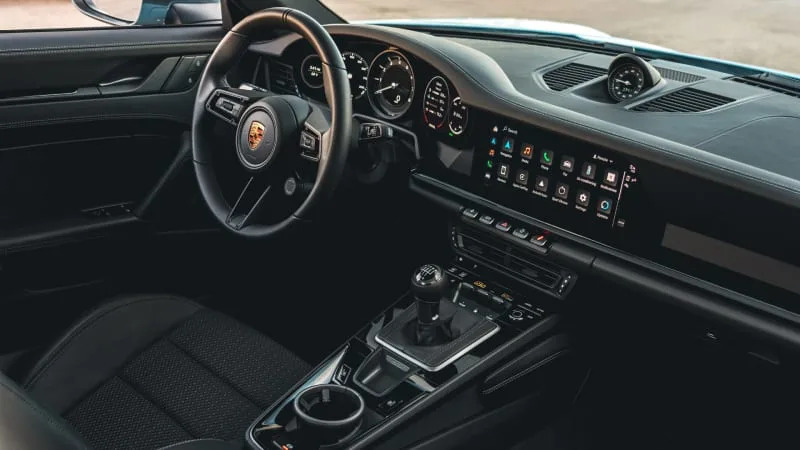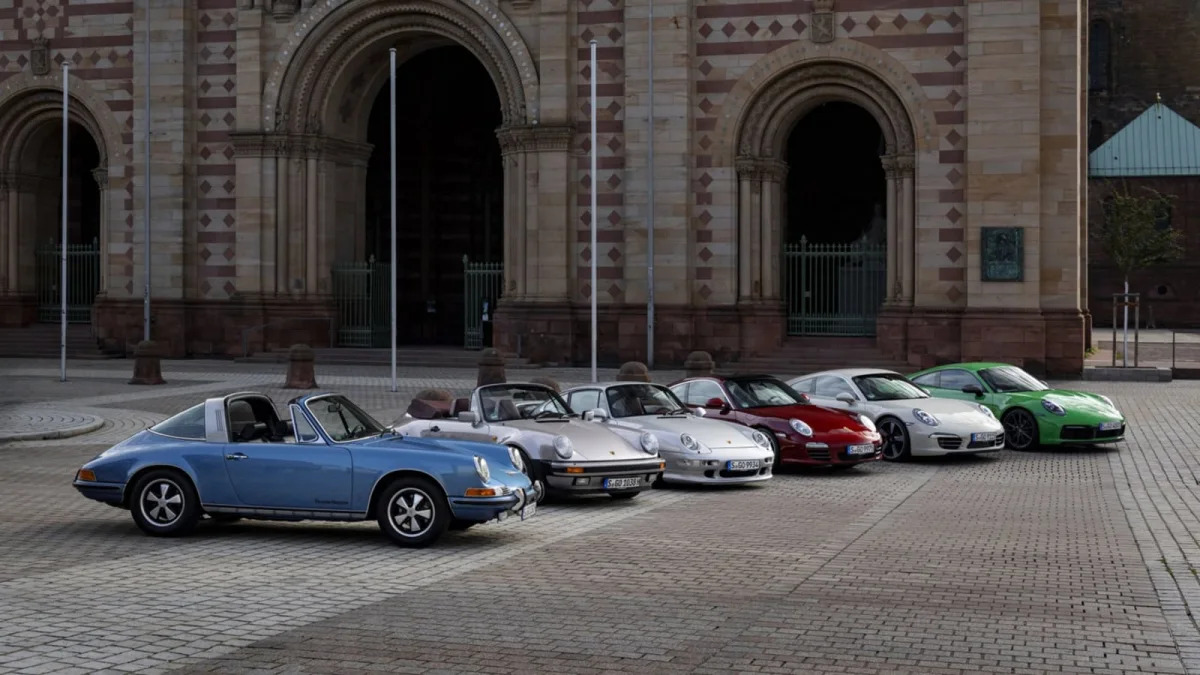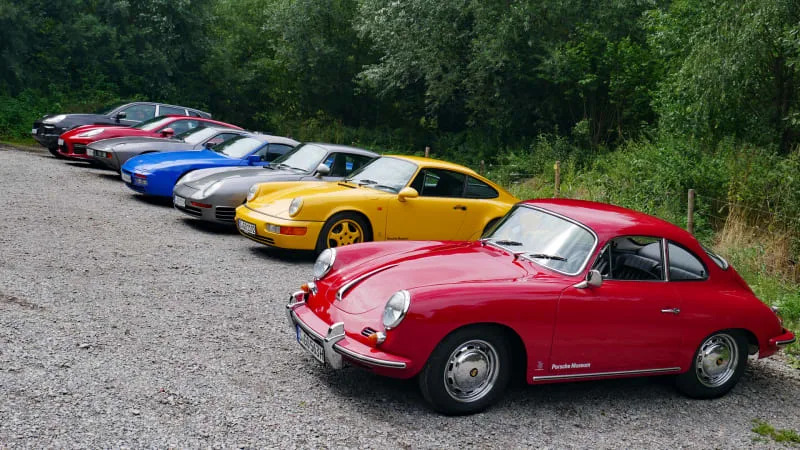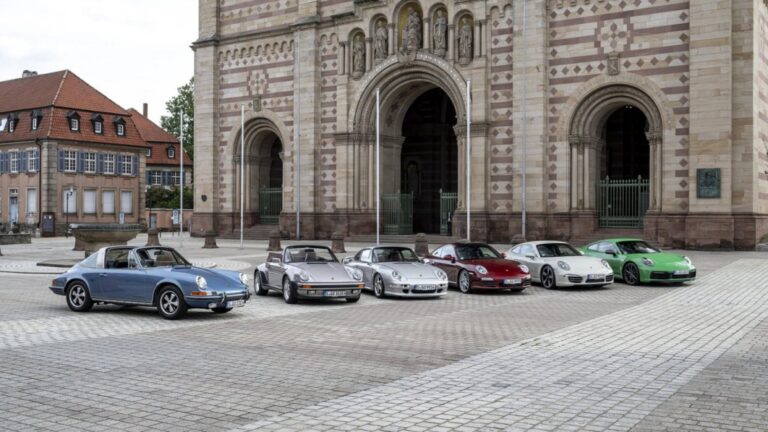If you listen to the left part of your brain, the Porsche 911 shouldn’t exist in 2023.
On paper, it’s an anachronism: It’s one of the last cars with a rear-mounted engine and one of the last with a flat-six engine. Being last at anything in the car industry normally means being behind the curve, yet demand for the 911 remains strong. Porsche sold 8,660 units in the United States from January to September 2023 versus 7,411 examples during the same period in 2022. Tellingly, the 911 outsold the Panamera (3,165 units) and the Taycan (5,212 units) combined during the first nine months of the year.
What’s its secret? I drove seven variants of the 911 built from 1970 to 2023 to find out.
“Heritage can’t be copied,” noted Alex Klein, the head of Porsche’s vehicle management and heritage experience. While carmakers can copy styling cues, interior layouts, and marketing techniques, that unmistakable silhouette and the wide instrument cluster don’t make the 911 what it is. They’re part of the DNA, but it’s the full strand (one that only exists in fossil form at most other carmakers) that defines it.
The oldest car available for me to drive was a 1970 911 S 2.2 Targa, a body style Porsche released in an era when the safety of full convertibles was increasingly being called into question. Your head served as the roll bar in many popular roadsters built during the 1960s, like the Alfa Romeo Duetto and the MG B. As the fear of a ban loomed, Porsche added a fixed steel safety bar, a removable roof panel that fit neatly in the trunk, and a detachable rear window. “Some day, all convertibles will have a roll bar,” a period ad read.
At the opposite end of the spectrum, the newest car in the pack was a 2023 911 Carrera T. Beyond the exterior design, the overall driving experience stands out as the red thread linking both cars. You sit low on seats that strike a nice balance between comfort and performance, you face a horizontal instrument cluster with five individual gauges (all of them are digital except for the tachometer in the 2023), and you look over a long, sloping hood with bulging fenders on either side. The ignition (a key in the Targa and a switch in the T) is positioned on the left side of a shallow, rectangular dashboard. Everything is familiar.
Crucially, the facets of the 911 that can’t be touched or quantified feel similar across the generations as well. It’s the overall behavior: Then and now, and with the exception of outliers like the GT2 RS, the 911 doesn’t pretend to be a race car. It’s sporty above all but it remains usable as a daily driver. Accessible performance, not flat-out performance, has always characterized the core members of the 911 range. Even the much-maligned 996-generation model, which jolted the automotive world by ditching the round headlights and adopting a water-cooled engine, ticks this box. It’s an acquired taste for many enthusiasts (one that an increasing number of collectors are saying “yes” to) but it’s distinctly a 911.
Another point linking every street-legal 911 built is a rear-mounted engine – I singled out “street-legal” because the 911 RSR built for endurance racing uses a mid-mounted engine. Common in the 1950s and the 1960s, this layout was gradually escorted off the scene as the packaging and handling advantages of a front-mounted engine came to light. The 911 has faithfully stuck with it, flying right in the teeth of those who argue building a car with the engine hanging off the ass end is like using a Minitel in the smartphone era.
That’s not to say they all drive the same. The original Targa feels rear-heavy but relatively laid back. It leans more into turns than newer 911s and it has the least direct shifter of the bunch. The 1983 Carrera Cabriolet Turbo-Look, with its 930-inspired punched-out rear wheel arches and 230-horsepower flat-six, offers firmer and more playful handling, while exploring the upper limits of the 450-horsepower 1998 Turbo S requires attentively listening to what the chassis is communicating and promptly backing off when it starts to protest. It’s not unpredictable, but you can clearly tell by the way it behaves on a twisty road (notably by analyzing how the chassis reacts to the different level of grip available on the front and rear axles in each specific bend) that its policy is to only warn you once before giving out a red card.
Newer 911s, including the 2008 Targa 4S and the 2013 50th Anniversary Edition (pictured below), leverage a growing armada of driving aids to bring rear-biased handling into the modern era. It becomes smoother and easier to tame, though it’s no less entertaining. The optional all-wheel-drive system fitted to the Targa greatly affects the driving behavior by adding grip that’s perceptible during high-speed cornering and by evening out the weight distribution. In the 2023 Carrera T, features like rear-wheel steering, torque vectoring, and adaptive dampers deliver a sharper, more balanced kind of rear-biased handling. You can drive it hard and have a blast without white-knuckling it.
The sound remains common, and it’s highly distinctive, but there are several variations of it. Early air-cooled cars emit more of a whine, while water-cooled cars have more of a grunt. It’s like listening to The Offspring’s anthology in chronological order: Some albums have more of an unpolished punk vibe, others lean more towards the clean-cut pop side of the scale, but the basic style remains recognizable.
Despite the 911’s old-school, true-to-heritage features, the model has gone through major evolutions in the past six decades. It’s notably much bigger and more powerful: Launched in the United States for 1965, the original 911 came with a 2.0-liter naturally-aspirated flat-six rated at 130 horsepower (a 90-horsepower, 1.6-liter flat-four was standard in the entry-level 912) and measured 164 inches long and 63.4 inches wide. Fast-forward to 2023: The base 911 Carrera ships with a 3.0-liter flat-six that’s turbocharged to 379 horsepower, and it measures about 178 inches long and a Nissan Frontier-like 73 inches wide excluding the door mirrors.
“Evolutions” is the key word in the last paragraph, as the closest the 911 has ever gotten to “revolution” was the 996. This explains why today’s 911 is not considered retro. “Authentic” is a more accurate way to label it.
Most buyers don’t care about authenticity. Ford’s decision to put the “Mustang” name on an electric crossover was mostly shrugged off, as was Porsche’s choice to sell SUVs or give a version the electric Taycan the name Turbo. Android Auto comes up more often than the intricacies of the Mezger flat-six engine when you talk cars with the average driver. There’s a small pool of buyers concerned about authenticity, however, and their options are limited. Setting the 911 aside, we have the Jeep Wrangler and the Mercedes-Benz G-Class, though the latter moved away from its roots as over-evolved farm equipment decades ago. Debatably, the Mazda MX-5 Miata also deserves the “authentic” label, though not from a visual standpoint.
Authenticity isn’t the sworn enemy of progress. Porsche went to court to defend its decision to install a rear spoiler on the limited-edition Carrera RS 2.7 released in 1972, and the ruling had a monumental effect on the design and handling of sports cars for decades to come. Active spoilers later replaced fixed spoilers, allowing Porsche to dial in the required downforce without significantly altering the 911’s silhouette, and lessons learned on the track gradually permeated production cars. The 993-generation Turbo S that I drove – one of 435 units built – features quarter panel-mounted air intakes like the 959’s and carbon fiber interior trim to save weight, for example. When customers asked for more in-car technology features, Porsche responded by neatly integrating a touchscreen into the 911’s center stack.

Countless smaller details have changed as well. In early 911s, the driver sits in front of floor-hinged pedals and a jumbo-sized steering wheel. The doors are equipped with pivoting quarter windows, and there isn’t a center console so the tall, slightly bent shifter pops up from the floor. Cupholders? No way, just crotch it. These features gradually either disappeared or evolved, so while every 911 has a similar interior layout it’s been marinated in the design trends and the technology of its era. Pivoting quarter windows disappeared by the time the SC model arrived for 1978 and a center console made its way into the space between the front seats (it could accommodate a storage compartment for cassettes). More speakers grew on the doors, more switches sprouted across the interior, and screens landed later.
Driving these seven cars back-to-back over two days highlighted that Porsche only updates the 911 when it makes sense to from a heritage perspective. That’s part of what makes every 911 a 911: It’s true to its soul and unfettered by trends that would alter it. The current-generation car has a modern, touchscreen-based infotainment system and an electronic parking brake, but I wouldn’t bet on seeing a variant with autonomous driving technology, a retractable steering column, and a lounge-like interior anytime soon.
With that said, it’s difficult to predict what’s next for the 911. Porsche knows, but it’s playing its cards close to its chest. On one hand, the brand has confirmed an inevitable hybrid system to ensure the model doesn’t end up in the middle of a regulatory bullseye on both sides of the Atlantic. On the other hand, executives pledged to keep the 911 away from the EV side of the range for as long as possible.
E-fuels will play a major role in extending the flat-six engine’s lease on life, especially in regions like the European Union where regulations, not natural market forces like customer demand, now filter the product pipeline of carmakers positioned all over the automotive spectrum. In a battle that looked lost before the first shot was fired, Germany convinced the European Union to exempt cars that burn some type of synthetic fuel from the piston-powered engine ban scheduled to come into effect in 2035.

Porsche is one of the industry’s loudest proponents of synthetic fuels; it notably built and operates a plant in Chile. Porsche has also clarified that its entire range will go electric at some point – even the 718 Boxster and 718 Cayman duo, so get a gasoline-burning one while you can! – with one exception: the 911. Reading between the lines suggests the multi-million-dollar synthetic fuel project, an endeavor that could one day position the firm as a rival to Shell and Chevron, received the green light to save the 911. This falls in line with its policy of making evolutionary updates in the name of authenticity.
The 911s that I drove in Germany all burned a blend of gasoline and synthetic fuel, and I didn’t detect the difference until someone from Porsche pointed it out. If you stick your nose within a few inches of the exhaust outlet you’ll notice the fumes have a slightly different smell, but all of the cars – even the older ones equipped with carburetors – started, idled, accelerated, and sounded completely normal.
Porsche could have morphed into a brand known for SUVs: The Macan and the Cayenne represented over half of its sales in the United States in 2022, with the 911 finishing a distant third. And yet, the 911 remains its icon; it’s the trunk of the family tree. Non-enthusiasts can’t ignore it because it features a shape nearly everyone recognizes, much like a Vespa and a Beetle. Enthusiasts can’t ignore it, either. Some love it and spend hours debating the pros and cons of the different generations; others think it’s overrated and overvalued and spend hours arguing why it’s not as good of a driver’s car as this or that.
Either way, the 911 is still here, against a great many odds, and it will be in the foreseeable future.
Happy 60th, 911.
Related:
Not just the 911: Retro reviews of five classic Porsche from 356 to 959
We go beyond the 911 with drives of other classic Porsches (although there’s still one 911)



